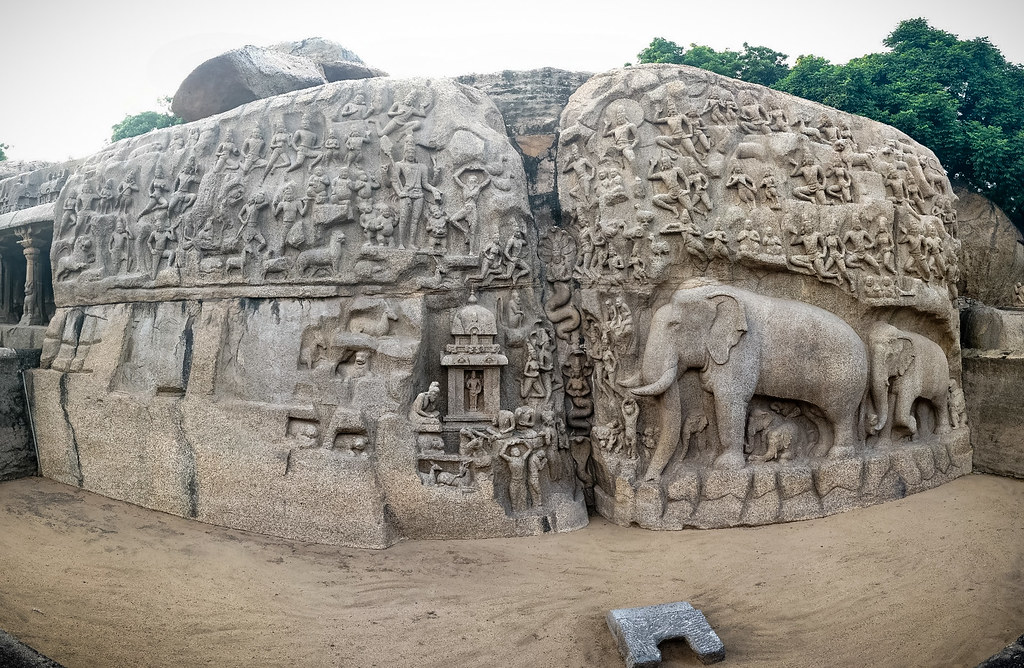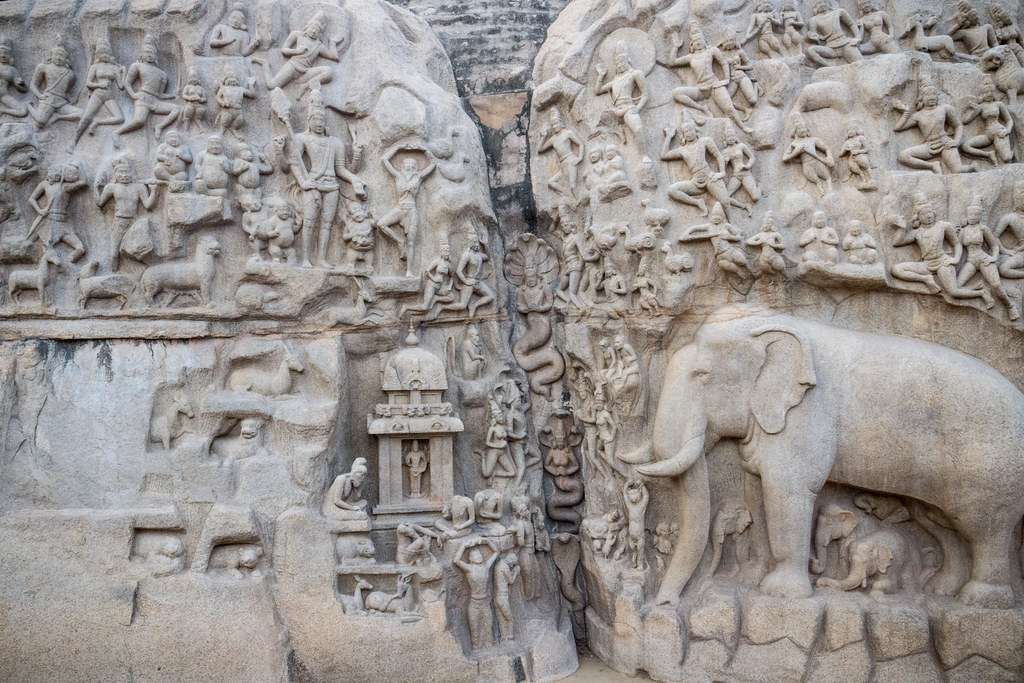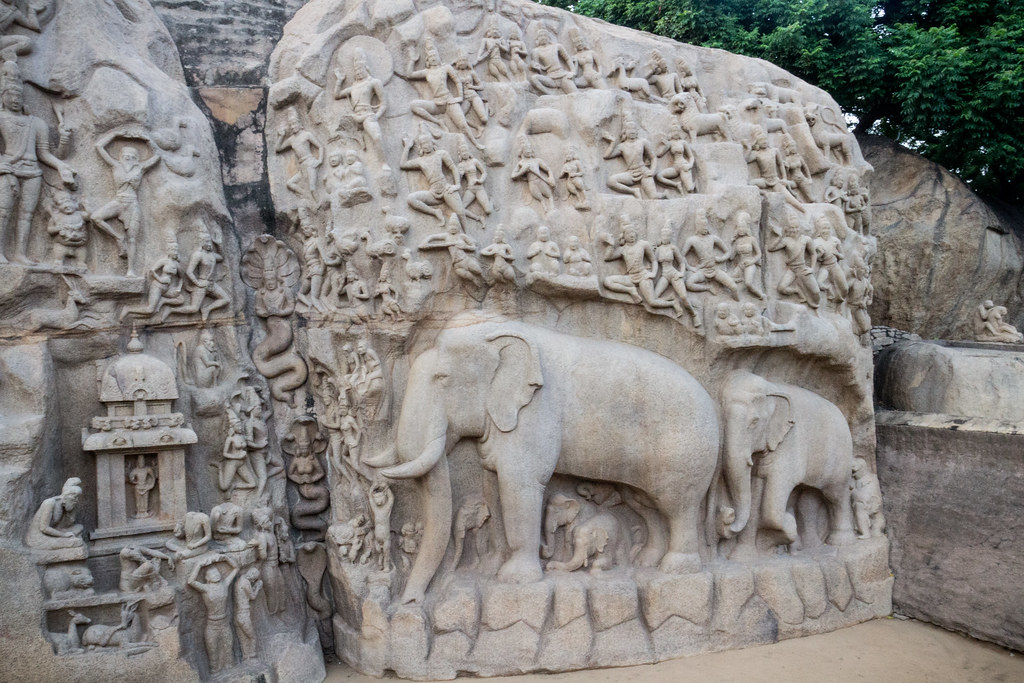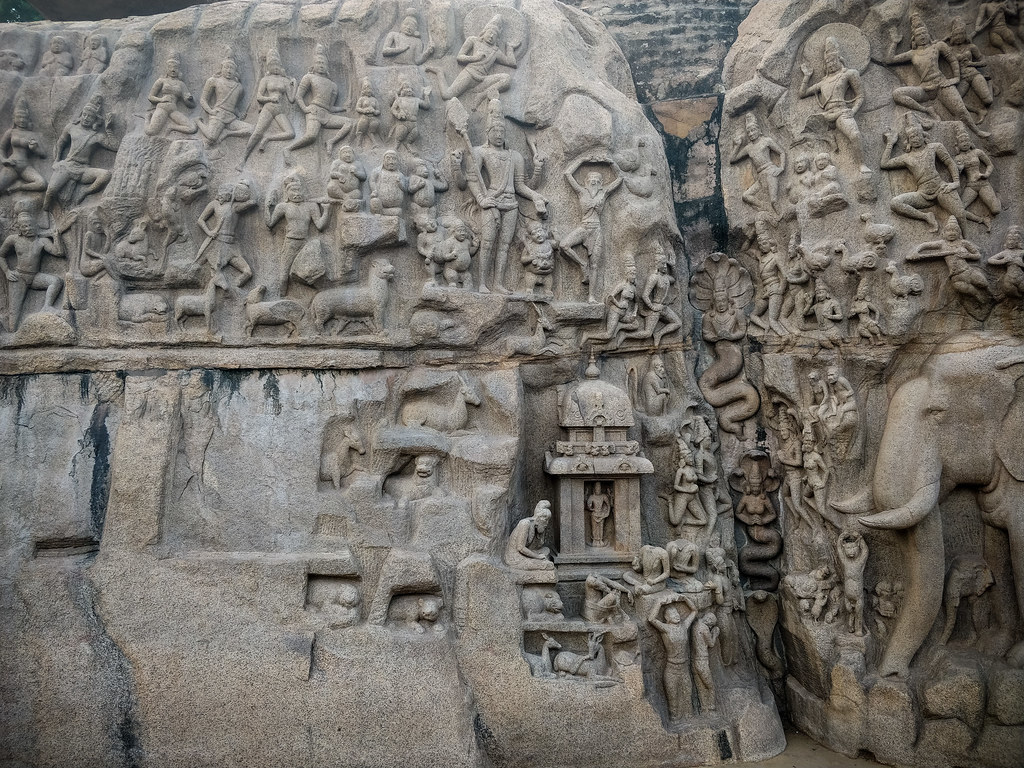The Arjuna relief is in the centre of Mahabalipuram, facing the sea at a short distance from the shores of the Coramandel Coast of the Bay of Bengal where the Shore Temple is situated.
Layout
The relief faces east. It was created with great skill and imagination on two large boulders of pink granite in the open air giving the whole a natural effect. The boulders measure 15 by 30 metres (49 ft × 98 ft). Many of the figures carved are in life size. The natural cleft, a very large perpendicular fissure, is skilfully sculptured. It is in between the two boulders and is integral to the mythical narratives carved on the entire relief. A water tank was once located at the top of the rock to release water denoting the Ganges River. It cascaded over the cleft and the relief to give the impression of the Ganga descending from the head tied matts of Shiva. This scene was created during festive occasions and the presence of a brick masonry cistern at the top of the cleft to release water attests to its location at site. The relief is an ensemble of over a hundred figures (146 is also mentioned) of god’s, people, half-humans and animals and is best explained by an expert at site.
History
The relief was created to celebrate the victory of Narasimhavarma over Chalukiya king Pulikesy. The place, now known as Mamallapuram, was earlier known by the epithet given to the king Narasimhavarman I (630–668 AD) of the Pallava Dynasty (who ruled from 4th to 9th centuries),) as Mamallan, the “great wrestler” or “great warrior” who came in the Malla dynasty. His father was king Mahendravarman I. The architectural creations at Mamallapuram, mostly attributed to Mamalla in the 7th century, adopted stone as the medium for sculpting in situ rock faces, which until then was done with some perishable material like wood or loose stones.
It is part of 25 UNESCO World Heritage Cultural Sites in India, and as a protected monument, the Archaeological Survey of India (ASI), Chennai Circle is entrusted with its upkeep in all aspects. The open air reliefs (including the Descent of the Ganges (Mamallspuram) are one of the four categories under which UNESCO identified the site as a World Heritage Site and inscribed it in 1984 under the title Group of Monuments at Mahabalipuram. This relief in rock is reported as a “sublime” early sculpture of the 7th century; even in the subsequent dynasty of the Chola’s adopted the shrine-sculpting technique in the temples they built in the late 9th century. This architectural legacy of the Pallava dynasty is continued by the descendants of sculptors of that period, who are now integrated into the present town’s culture.
Architecture
The sculptures carved in the natural fissure that divides the cliff not only depict a cosmic event of Ganges descending to earth (a popular narration and depiction in the iconography of Shiva) at the command of Shiva but also shows the event being watched by scores of gods, goddesses, mythical figurines of Kinnara , Gandharva , Apsara, Gana, Nagas, and also wild and domestic animals, all admiringly looking up at the scene. This relief is often given the hyperbole adjectives as “world renowned” and “unique artistic achievement”. The total number of carvings are probably about 146.
The carvings of elephants are almost life size. Another humorous scene is the carvings of monkeys copying the yogic scenes of the sages. Shiva is shown next to the Kinnaras who are depicted in large numbers in the upper portion of the relief; they are anthropomorphic forms of half human half bird, a popular Indian art form in ancient times representing the Indic ethos of the world as one creation. The male Kinnara is holding a musical instrument (type unknown) while the female Kinnara is holding a cymbal. Shiva is carved in front of the river (to the right of the cleft) in a standing posture with Bhagiratha, the sage, standing on one leg offering him prayers to check the force of the Ganga as she descends to earth. Shiva is also shown with a weapon which is interpreted as Pashupati, which he gave to Arjuna.
The ganas shown in the carvings represent the people who have spent their entire lives in dedication to Shiva, and are blessed with the boon to remain close to Shiva for all time to come. Carvings of the divine nagas shown swimming in the river, as Ganga descends from the heavens, are also in anthropomorphic form of a serpent and human, which has been a traditional style from ancient times in Indic art. They are believed to denote fertility and protective forces of nature. They are seen not only in the middle of the panel facing the cleft, which represents the river, but also at the top of the panel at the entry of water over the channel, marking the prevalence of naga worship in Hindu religious beliefs.
It is also said that the relief in one unity is the early Indic artist’s concept of “sublime continuity in all living things.” The elephants shown in reliefs are unique in the fact that the detailing includes the baby elephants behind the life size elephants. Another interesting depiction is of a deer scratching its nose. The elephants represent a herd moving towards the river to drink water. The male elephant carving precedes that of its female partner. Three baby elephants with the male elephant and two babies with the female elephant are also carved in the panel.
Sun, on the left and Moon on the right side are also depicted on top part of the panel. A kim-purusha, meaning dwarf with elongated ears and wearing a cap on his head and beating a drum is also seen in the panel.
In the upper part of the panel, Himalayas are shown which corroborates the theory of the panel representing the descent of the Ganges. Wild lions are also shown with large mane and also rams which are interpreted as representing the Himalayan habitat. On the left side of the upper panel, carvings of divinities and celestial couples moving towards the river are seen. A few animals, lions and monkeys are also carved in this part. Two pairs of kinnaras and three pairs of celestial couples are shown flying in the air approaching the river (cleft). Hunters and hunting scenes are part of this part of the panel; a hunter with a bow, two hunters hiding under trees to hunt, a lion about to attack two hunters are some of the parts of forest scenes carved on the panel. Another scene below is of few monkeys, and carving of a lion in his den with few deer in front of it. Carvings of hunters carrying a pitcher and another carrying the hunted animals are also seen.
Another prominent scene is that of a temple to the right of the cleft at the lower end of the panel. This temple is simple and small and has Vishnu as the deity carved within it. The temple roof is patterned on the style of Draupadi Ratha with a square curvilinear dome type of tower. However, the top is flat and is fitted with a stupi, with a kudu in the centre. Corners are decorated with flower designs. The cornices are also seen with kudus carved with human faces inside. In the floor above the cornice, lion motifs are carved. A square supports the domed roof. A sage is seen sitting in front of the temple giving sermons to his students. In the seat below this scene, a lion in his den and below this a pair of deer are carved. A tortoise is shown next to the temple indicative of water in the near vicinity





Great post 😁
LikeLike
woah, this is amazing! very good post!
LikeLiked by 1 person